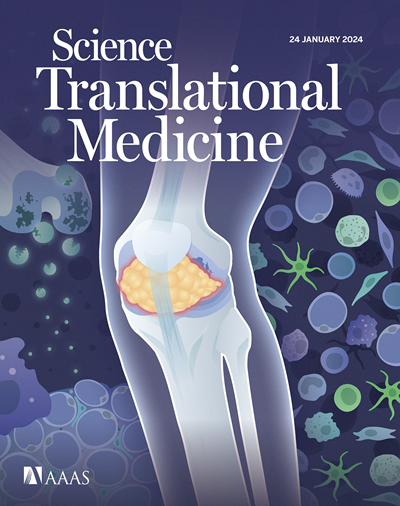PARP抑制剂治疗期间减轻T细胞DNA损伤,增强抗肿瘤疗效
IF 15.8
1区 医学
Q1 CELL BIOLOGY
引用次数: 0
摘要
聚(adp -核糖)聚合酶抑制剂(PARPis)是一类靶向DNA损伤修复的药物,已成为上皮性卵巢癌(EOC)和多种其他实体肿瘤的标准治疗方法。除了靶向DNA损伤修复外,PARPis还积极调节抗肿瘤免疫反应,其疗效部分依赖于T细胞活性。在这里,我们发现患者T细胞在PARPi治疗期间持续DNA损伤,从而降低了治疗效果。利用新辅助尼拉帕尼单药治疗EOC患者的临床试验中配对的治疗前和治疗后肿瘤样本,我们发现PARPi引起DNA损伤,减缓增殖,增加T细胞凋亡,我们在体外和小鼠模型中验证了这一点。在原代人T细胞中进行全基因组CRISPR基因敲除筛选,发现PARP1是parpi诱导T细胞死亡的主要媒介。在转基因小鼠中,T细胞特异性缺失PARP1或使PARP1结合位点发生突变,导致PARPi治疗期间T细胞DNA损伤减少,从而提高PARPi单独或联合免疫检查点抑制的疗效。然后,我们利用胞嘧啶碱基编辑技术改造parpi耐受CAR - T细胞,减少parpi诱导的PARP1捕获,减少parpi诱导的DNA损伤,与亲代CAR - T细胞相比,在异种移植模型中产生了更好的抗肿瘤功效。这项研究强调了parpi诱导的DNA损伤与T细胞的相关性,并提出了提高parpi作为单一疗法或与免疫疗法联合使用的疗效的机会。本文章由计算机程序翻译,如有差异,请以英文原文为准。

Mitigating T cell DNA damage during PARP inhibitor treatment enhances antitumor efficacy
Poly(ADP-ribose) polymerase inhibitors (PARPis) are a class of agents targeting DNA damage repair that have become standard therapy for epithelial ovarian cancer (EOC) and multiple other solid tumors. In addition to targeting DNA damage repair, PARPis actively modulate antitumor immune responses, with efficacy being partially dependent on T cell activity. Here, we found that patient T cells sustain DNA damage during PARPi treatment, which reduces treatment efficacy. Leveraging paired pre- and posttreatment tumor samples from a clinical trial of patients with EOC treated with neoadjuvant niraparib as monotherapy, we showed that the PARPi caused DNA damage, slowed proliferation, and increased apoptosis in T cells, which we validated both in vitro and in mouse models. A genome-wide CRISPR (clustered regularly interspaced short palindromic repeats) knockout screen in primary human T cells identified PARP1 as the principal mediator of PARPi-induced T cell death. T cell–specific deletion of PARP1 or mutating Parp1 at its binding sites in transgenic mice led to reduced T cell DNA damage during PARPi treatment, resulting in improved efficacy of PARPis, alone or in combination with immune checkpoint inhibition. We then engineered PARPi-tolerant CAR T cells using cytosine base editing, which decreased PARPi-induced PARP1 trapping and led to reduced PARPi-induced DNA damage, resulting in superior antitumor efficacy in xenograft models compared with parental CAR T cells. This study highlights the relevance of PARPi-induced DNA damage to T cells and suggests opportunities to improve the efficacy of PARPis as monotherapy or in combination with immunotherapy.
求助全文
通过发布文献求助,成功后即可免费获取论文全文。
去求助
来源期刊

Science Translational Medicine
CELL BIOLOGY-MEDICINE, RESEARCH & EXPERIMENTAL
CiteScore
26.70
自引率
1.20%
发文量
309
审稿时长
1.7 months
期刊介绍:
Science Translational Medicine is an online journal that focuses on publishing research at the intersection of science, engineering, and medicine. The goal of the journal is to promote human health by providing a platform for researchers from various disciplines to communicate their latest advancements in biomedical, translational, and clinical research.
The journal aims to address the slow translation of scientific knowledge into effective treatments and health measures. It publishes articles that fill the knowledge gaps between preclinical research and medical applications, with a focus on accelerating the translation of knowledge into new ways of preventing, diagnosing, and treating human diseases.
The scope of Science Translational Medicine includes various areas such as cardiovascular disease, immunology/vaccines, metabolism/diabetes/obesity, neuroscience/neurology/psychiatry, cancer, infectious diseases, policy, behavior, bioengineering, chemical genomics/drug discovery, imaging, applied physical sciences, medical nanotechnology, drug delivery, biomarkers, gene therapy/regenerative medicine, toxicology and pharmacokinetics, data mining, cell culture, animal and human studies, medical informatics, and other interdisciplinary approaches to medicine.
The target audience of the journal includes researchers and management in academia, government, and the biotechnology and pharmaceutical industries. It is also relevant to physician scientists, regulators, policy makers, investors, business developers, and funding agencies.
 求助内容:
求助内容: 应助结果提醒方式:
应助结果提醒方式:


